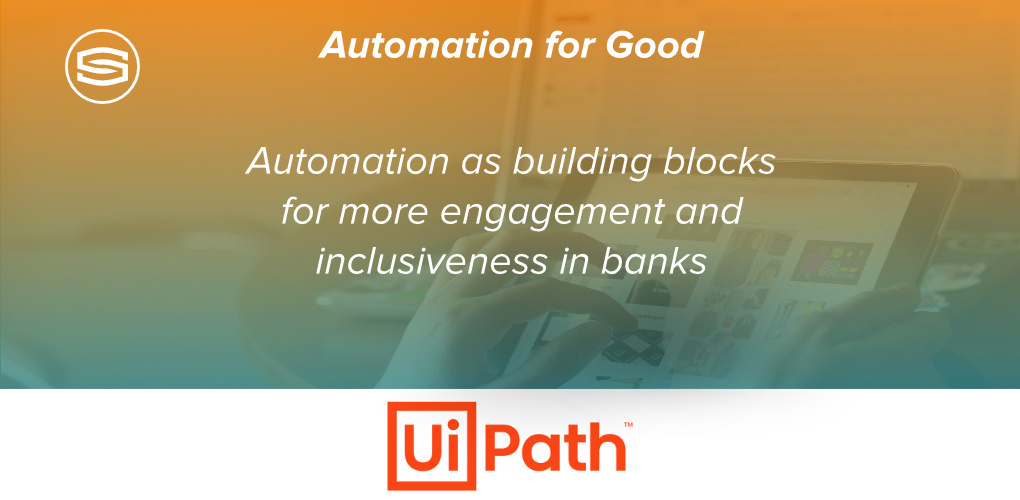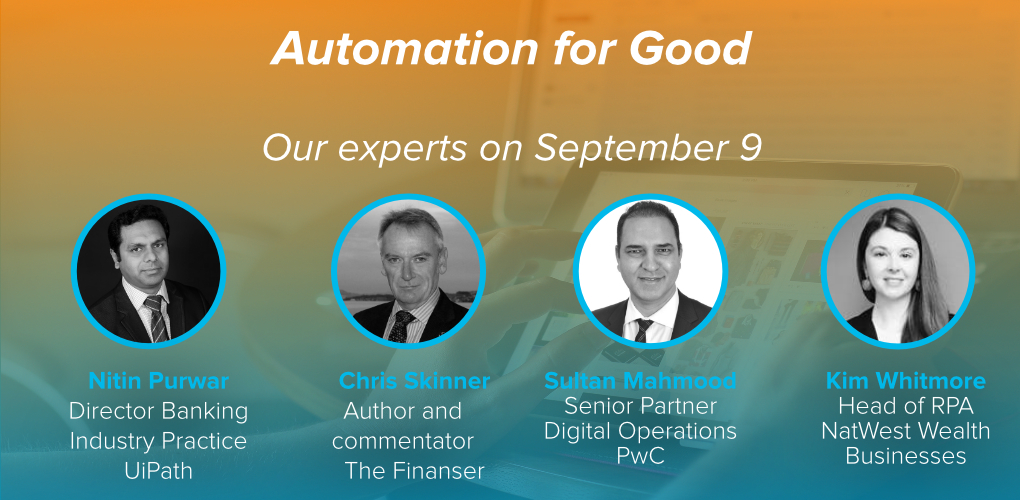
Insights & Opinions
Automation as building blocks for more engagement and inclusiveness in banks
Wed, 29 Sep 2021


As the world pivots from shareholdership to stakeholdership, banks feel the pressure from customers, investors, and society in general to dedicate more resources and attention to topics like ESG and sustainability.
How can banks quickly respond to these voices? As Chris Skinner, one of the most influential voices in technology and financial services, said: "It's not just talking the talk. It's actually committing to walk the walk."
In a session titled "Automation for Good: Automation as an enabler for ESG and Sustainability in Banks", Chris Skinner was one of the panellists on September 9, together with:
- Kim Whitmore, Head of RPA, NatWest Wealth Businesses
- Nitin Purwar, Director Banking Industry Practice at UiPath
- Sultan Mahmood, Senior Partner Digital Operations, PwC

We spoke about "automation as an enabler for a greener future in banks" earlier. During the session on September 9, we talked about a lot more. In this blog, we dedicate more time to how automation contributes to a better work environment and more inclusive banking.
By the way: the recordings of the entire session can be viewed here.
Automation for more engaged bankers
The pandemic made everyone adapt to a new digitally connected reality. Bank customers and employees faced a new era of banking, with digital banking at the heart of this. As we know, change creates challenges, one of them being people that risk missing out because of homeworking.
Kim: "NatWest took a really supportive approach to people's wellbeing and looked at how to get through this time and pull together. RPA became a fundamental thing during that period to take some of the load off of our frontline colleagues, for example, and help them to focus on the stuff that they need to do for our customers."
As people are now slowly returning to the office, it was revealing to hear from Kim that rather than looking at the amount of FTEs saved, their RPA KPIs measure the number of hours that people returned to the business to focus on other activities.
Kim explained this with an example: "We worked with a colleague in operations to automate some processes in his team in the anti-money laundering area. They had a colleague who was suffering from repetitive strain injury from clicking a button over and over again. You know, one of those processes that we shouldn't still have people doing, and we automated that."
This triggered many more ideas, and with the support of the RPA team, he ended up automating more processes and eventually got an internal promotion to become a business analyst.
RPA helped reduce workloads off of people and ignited the mindset across the organisation to use the technology for a more enjoyable workplace. That is extremely important in uncertain times. Kim: "Sometimes it is feeling motivated and feeling that you're doing something meaningful at work, which we certainly can contribute to."
Nitin shared an exciting example of health robots: "Every Monday the bot checks how the employee's health is. If the feedback isn’t positive, someone from the bank will come and ask you what happened. It's a small task, but a very meaningful way for an organisation to check on an ongoing basis about the health of all of the employees, right every week. It makes us realise that the organisation is caring."
We are just at the start of enabling more employees in using robots to assist them in their work. Nitin: "We are democratising the use of some of these technologies. Everyone knows about the whole low code, no code movement, and that's one of our own objectives. How can we make technology so easy that everyone can consume it?"
Automation for better banking
Digital banking is not new, but too often, digital banking is used to create a lower-cost digital alternative for existing bank solutions. During the pandemic, the industry recognised that digital banking is more than simply helping people through an app.
Chris highlighted that today 15% of the global population has a disability. Chris: "This, to me, is a big discussion around ESG and financial inclusion. But beyond, it's about how do we rethink financial services digitally for inclusion."
These people are a minority that often fall behind the standardised digital banking services. Banks that help them through the branch network needed to find creative tactical solutions to continue that support during the lockdown.
Having a sister with cerebral palsy herself, Kim was proud to share NatWest's example of an automated process to send Sterling currency to vulnerable clients. Her sister could not enter a PIN, and the branch was the only way to get hold of cash. The opportunities of automation provided an alternative solution to let her access cash.
As an example of how automation can augment the emotional aspect of customer services, Sultan shared the example of a solution to help identify vulnerable customers. They developed "a voice solution trained on algorithms to see if the agent dealing with that customer is missing the point, that there is a vulnerable customer here and flagging that up to that individual in real-time so that they can be treated in the appropriate manner going forward."
Suddenly technology is no longer a means to an end but an enabler in making banking more human again in a digitally connected world.
Conclusion
Today, clearly, if we look at ESG, the most discussed topic is the environmental part. On the other hand, the G of governance and how to deal with your human capital and the S, of how to bring more value to society are evenly important.
Automation has the right set of tools to take new tactical steps in the right direction.
P.S.: if you like more on this topic, look at the interview we did with Nitin Purwar.
P.P.S.: as I said at the beginning of this article: the recordings of the entire session can be viewed here.



